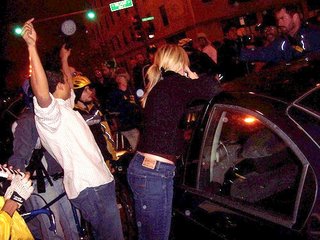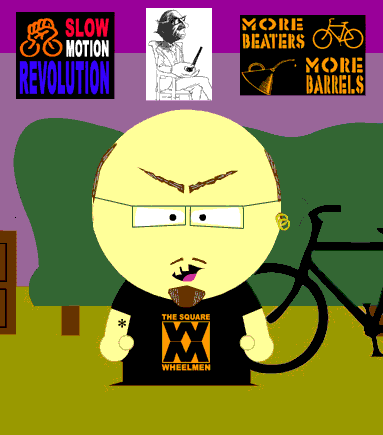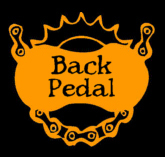31.3.07
30.3.07
One more reason why I roll
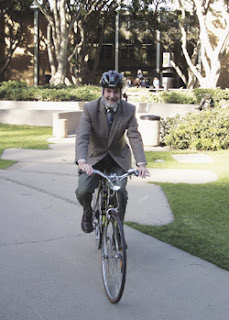 UCLA Urban Planning professor, Donald Shoup, discusses one of the big reasons I went carfree nearly ten years ago: all thefrustrating time I spent trawling for parking spaces.
UCLA Urban Planning professor, Donald Shoup, discusses one of the big reasons I went carfree nearly ten years ago: all thefrustrating time I spent trawling for parking spaces.For more on Shoup's research check out his book, The High Cost of Free Parking.29 March 2007: Most people view traffic with a mixture of rage and resignation: rage because congestion wastes valuable time, resignation because, well, what can anyone do about it? People have places to go, after all; congestion seems inevitable.
But a surprising amount of traffic isn’t caused by people who are on their way somewhere. Rather, it is caused by those who have already arrived. Streets are clogged, in part, by drivers searching for a place to park.
Labels: new urbanism, pensées, velotariat
29.3.07
It's fixed!
is rolling again

1 broken fingernail
copious cursing
lots and lots of grease
thanks for all
the comments of support
Labels: serious shit, that which rolls
28.3.07
Spindle failure

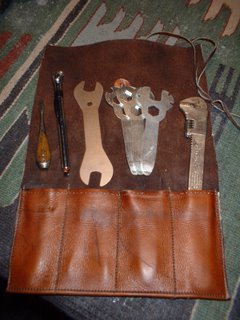 Last night on my commute that which rolls had it's first major structural failure. Halfway home from work a the bottom-bracket started emitting a strange grinding noise. Then the left pedal started going floppy. I stopped thinking I'd thrown a pedal bearing or perhaps the crank was loose. So I tightened both the pedals and cotter pins as best I could and rolled on.
Last night on my commute that which rolls had it's first major structural failure. Halfway home from work a the bottom-bracket started emitting a strange grinding noise. Then the left pedal started going floppy. I stopped thinking I'd thrown a pedal bearing or perhaps the crank was loose. So I tightened both the pedals and cotter pins as best I could and rolled on. After about 50 meters, the left crank fell onto the street! Thank G-d I wasn't going very fast or standing on the pedals ... the good news is I have a spare from the Raleigh I bought earlier this summer. So today, I'll dip into Glenn's Complete Bicycle Manual and get my hands dirty %)
After about 50 meters, the left crank fell onto the street! Thank G-d I wasn't going very fast or standing on the pedals ... the good news is I have a spare from the Raleigh I bought earlier this summer. So today, I'll dip into Glenn's Complete Bicycle Manual and get my hands dirty %)Labels: serious shit, that which rolls
27.3.07
To read or not to read...
Well, at least it is for Moscow Times columnist and author Victor Sonkin who writes,
HarperCollins UK recently announced plans to publish a version of Leo Tolstoy's "War and Peace" that will be two-thirds the length of the original. The text is based on one of Tolstoy's drafts (already issued in Russia by Zakharov publishers in 2000) and it omits many of the lengthy French passages and philosophical ramblings. It also has a happier ending: Two major characters, Prince Andrei Bolkonsky and Natasha's brother Petya Rostov, survive, unlike in the canonical version.
...Is that a good thing? ... My opinion, though, is that someone who knows the basic plot and ideas of "The Aeneid" or "Beowulf" is better off than someone who doesn't have a clue. Besides, an energetic synopsis can spur some people to plunge into the real thing.
25.3.07
Bike lessons...
Every 10th trip in Berlin is made by bike. With more than 500 miles of bike lanes and paths, rush hour in this German city of 3.4 million can be a blur of two-wheeled commuters, from suited businessmen to mothers hauling toddlers in specially designed trailers. Schools of sightseers on guided bike tours are a common sight-as are tired tourists returning to their hotels in velotaxis (cabs in which the driver pedals). Even politicians ride to work, leaning their bikes against the marble walls of parliament buildings.
Heidi Wright of the German parliament's transportation committee says cycle-friendly policies make a difference. With government support, one of Germany's biggest health insurance companies offers premium discounts for people who bike to work. A dozen federally supported cycling routes crisscross the country, promoting tourism. And simple solutions--from funding bike lanes and bike racks to requiring bigger mirrors to help trucks see bikers--combine to make riding more appealing.
Life cycle. As densely populated cities across Europe battle traffic, booming bike use couldn't be better timed. Studies have shown that for trips under 3 miles, bicycles are often the fastest alternative. Cycling mileage in London has doubled since the city began charging those who drive cars downtown up to $16 a day. High gas taxes all over Europe encourage more drivers to leave their cars parked. "Quality of life increases when cycling increases," says Wright. "We need to get that into the heads of mayors and politicians."
But even Germany will have a hard time catching up to Europe's cycling capital, Holland. Beginning in the 1970s, Dutch politicians and planners made cycling a priority. "The Netherlands has the highest share of cycling as a mode of transport in the world," says Roelof Wittink, a cycling advocate in Utrecht. More than a quarter of all trips taken in the Netherlands are by bike. Cycling's huge popularity with commuters has forced planners to tackle problems unimaginable elsewhere, like creating space for the 20,000 bicycles left at the Utrecht train station daily. Cycling is so common that the tag "cyclist" has no meaning, Wittink says: "Everyone is doing it-young people, retired people, mothers, ministers, members of the royal family."
Labels: new urbanism, pensées, rolling abroad
23.3.07
Shanghai bike lanes
the streets for bikers
Shanghai Daily, 20 March 07: ...The city is renovating a 300-kilometer network of "cycling arteries," covering at least 60 percent of local roads open to cyclists, and plans to separate bicycles from motorbikes and scooters in some busy areas. The government also plans to follow what London does: Using colorful road material to pave cycling lines and make them more noticeable. The efforts were inspired by a recent government-based survey showing nearly 30 percent of locals use bikes, motorbike or scooters as their regular transport.
However, cyclists in Shanghai face "multiple challenges" - fewer and narrow lanes, car exhaust fumes, sharing roads with motorbikes and rampant bike thieves. There are no official statistics for the city's total number of cyclists because the Chinese government puts cyclists, scooters and motorbikes in the same category.
"We believe bicycles are still very important in locals' lives," Yuan Wenping, a chief engineer of Shanghai Engineering Administrative Bureau, said yesterday. Asked by the city leaders to draw up a new cycling plan, Yuan and his colleagues have worked out a "no-block" cycling network through 2020. The network will incorporate 25 "cycling arteries" - 13 south-north and 12 west-east - within the Outer Ring Road, which encloses the 600-square-kilometer downtown area.Each of the arteries - either one-way or two-way cycling lanes alongside vehicle lanes - cross up to 10 roads. Most roads are close to the city's Inner Ring Road, Yan'an Road and South-North Elevated Road ... Yuan said: "The network will enable cyclists to reach most downtown spots on pedals."... Currently, most cycling arteries feature lanes that are not linked or too narrow, causing difficulty for long-distance cyclists.
...Over the past decade, cycling has been banned on more than 70 kilometers of downtown main roads, such as Huaihai Road, Yan'an Road, Zhongshan Road E1, Nanjing Road and parts of Siping Road. The former cycling lanes were used to carry the rapid increase of vehicles, which include both private and government-funded cars.
Bicycles were a very desirable and convenient transport in China in the 1950s or 1960s, when a typical bike cost around 170 yuan (US$21) - about five times more than an ordinary worker's salary. Today, a standard bike sells for around 300 yuan, but the city's average salary has climbed to more than 2,000 yuan.
In many western cities such as New York, cycling is a form of sport, and most people take subway or bus to work every day. In China, however, many people still follow the tradition of using bikes every day because it's cheap, easy to use and quick.Difficulties facing today's cyclists include the mixture of motorbike and cycling lanes as well as errant drivers, making cycling a "dangerous game" in the city. Another problem is the rampant rate of bike theft, and what the police can do is very limited.
As more and more subway lines and vehicles appear, the bicycle's role may not appear as powerful as 50 years ago in China. But one thing is for sure: the government will not ban cycling on most downtown roads.
Labels: new urbanism, rolling abroad, velotariat
22.3.07
Is it about a bicycle?
The Third Policeman
The gross and net result of it is that people who spend most of their natural lives riding iron bicycles over the rocky roads of this parish get their personalities mixed up with the personalities of their bicycle as a result of the interchanging of the atoms of each of them and you would be surprised at the number of people in these parts who nearly are half people and half bicycles.
 So begins a brilliant, surreal novel with an enormous otherworldly policeman explaining his Atomic Theory as it relates to bikes. It's author was born Brian O’Nolan. While his English novels appeared under his pen name, his other novels and newspaper column, appearing from 1940 to 1966, were signed Myles na gCopaleen or Myles na Gopaleen - the second being a phonetic rendering of the first.
So begins a brilliant, surreal novel with an enormous otherworldly policeman explaining his Atomic Theory as it relates to bikes. It's author was born Brian O’Nolan. While his English novels appeared under his pen name, his other novels and newspaper column, appearing from 1940 to 1966, were signed Myles na gCopaleen or Myles na Gopaleen - the second being a phonetic rendering of the first. The Third Policeman almost didn't get published. O'Brien's publisher, was unhappy with it, advising that: he should become less fantastic and in this new novel he is more so. More rejections followed. He wrote desperately to William Saroyan in September 1940,
The Third Policeman almost didn't get published. O'Brien's publisher, was unhappy with it, advising that: he should become less fantastic and in this new novel he is more so. More rejections followed. He wrote desperately to William Saroyan in September 1940, I got so sick looking at a ragged […] copy of that story I wrote about the policeman that I flew into a frenzy (the Sweeny kind), put it into a box with 2 short stories and sent the whole lot across the sea to Matson & Duggan.
 His American agent ultimately misplaced the only copy of the manuscript. O'Brien began to spread the story that it had been lost completely. He never again offered it to a publisher. So The Third Policeman didn't appear in print until 1967, one year after O'Brien's death.
His American agent ultimately misplaced the only copy of the manuscript. O'Brien began to spread the story that it had been lost completely. He never again offered it to a publisher. So The Third Policeman didn't appear in print until 1967, one year after O'Brien's death.Later in the novel (Chapter 4), Policeman MacCruiskeen interviews the book's narrator.
Policeman MacCruiskeen put the lamp on the table, shook hands with me and gave me the time of day with great gravity. His voice was high, almost feminine, and he spoke with delicate careful intonation. Then he put the lamp on the counter and surveyed the two of us.
'Is it about a bicycle?' he asked.
'Not that' said the Sergeant. 'This is a private visitor who says he did not arrive in the townland upon a bicycle. He has no personal name at all. His dadda is in far Amurikey.'
'Which of the two Amurikeys?' asked MacCruiskeen.
'The Unified Stations,' said the Sergeant.'Likely he is rich by now if he is in that quarter,' said MacCruiskeen, 'because there's dollars there, dollars and bucks and nuggets in the ground and any amount of rackets and golf games and musical instruments. It is a free country too by all accounts.'
'Free for all,' said the Sergeant. 'Tell me this,' he said to the policeman, 'Did you take any readings today?'
'I did,' said MacCruiskeen.
'Take out your black book and tell me what it was like a good man,' said the Sergeant. Give me the gist of it till I see what I see,' he added.
MacCruiskeen fished a small black book from his breast pocket.
'Ten point six,' he said.
'Ten point six,' said the Sergeant. 'And what reading did you notice on the beam?'
'Seven point four.'
'How much on the lever?'
'One point five'There was a pause here. The Sergeant put on an expression of great intricacy as if he were doing far-from-simple sums and calculations in his head. After a time his face cleared and he spoke again to his companion.
'Was there a fall?'
'A heavy fall at half-past three.'
'Very Understandable and commendably satisfactory,' said the Sergeant. 'Your supper is on the hob inside and be sure to stir the milk before you take any of it, the way the rest of us after you will have our share of the fats of it, the health of it.
Policeman MacCruiskeen smiled at the mention of food and went into the back room loosening his belt as he went; after a moment we heard the sounds of coarse slobbering as if he was eating porridge without the assistance of spoon or hand. The Sergeant invited me to sit at the fire in his company and gave me a wrinkled cigarette from his pocket.'It is a lucky thing for your pop that is situated in Amurikey,' he remarked, 'if it is a thing that he is having trouble with the old teeth. It is very few sicknesses that are not from the teeth.' 'Yes,' I said. I was determined to say as little as possible and these unusual policeman first show their hand. Then I would know how to deal with them.
'Because a man can have more disease and germination in his gob than you'll find in a rat's coat and Amurikey is a country where the population do have grand teeth like shaving lather or like bits of delph when you break a plate.'
'Quite true,' I said.
'Or like eggs under a black crow.'
'Like eggs,' I said.
'Did you ever happen to visit the cinematograph in your travels?'
'Never' I answered humbly, but I believe it is a dark quarter and little can be seen at all except the photographs on the wall'.
'Well it is there you see the fine teeth they do have in Amurikey,' said the Sergeant.
Labels: books, pensées, rolling abroad, silly shit, writing
21.3.07
20.3.07
India's bike coal carriers
impoverished bikers who daily haul over 300 lbs across 27 miles of dangerous terrain.
Ramesh Hembrom begins his journey for Ranchi at midnight from Patratu on a bicycle laden with 1.5 quintals of coal. He reaches the Jharkhand capital in the evening the next day, playing hide and seek with death every time.
He completes the arduous 45-km journey in nearly 18 hours, cycling precariously through steep zigzagging hilly roads for a living even as death beckons him daily either in the form of an accident or a slow painful end from tuberculosis.
Hembrom earns Rs.300-400 from the sale. He does this twice a week, earning between Rs.2,000 and Rs.3,000 a month. "We pick up coal from closed and abandoned mines (of Central Coalfield Ltd, CCL) and sell them in Ranchi," explained Ramesh.
Poverty is the main reason for taking up such a job. The people who ferry coal thus face serious risk two ways - frequent accidents during the journey or tuberculosis overcomes them.
On steep roads, these men push the coal-laden bicycles with their chest, holding the handle with their hands. If the balance is lost, it can mean a free fall in the ditch alongside the road. Such ferrying can be witnessed on roads between Ranchi and Patratu, between Ranchi and Patna and in other places in Jharkhand. Thousands are engaged in the activity.
Kishna Mahto is another poverty-stricken coal carrier from the Rajarappa colliery, which is 60 km from Ranchi. He crossed the dangerous Ramgarh valley. "We know the risks. Every year more than 20 people die due to TB and an equal number meet with accidents. But we have no option but to engage ourselves in this business," said Mahto.
Coal ferrying is totally illegal as it is extracted illegally, mainly from abandoned mines. "Most people engaged in ferrying coal are poor and get involved for some money. The real culprits are the mafias who engage them in it," an official of CCL told IANS.
Such coal carriers are found in other districts as well, including Bokaro, Dhanbad and Giridih. Some suffering from TB are still engaged in this business.
"I am the only bread earner of my family. And so as long as I am alive, I will continue to carry the coal," said Somnath Baitha, now in his 40s. He moves coal from the Rajarappa colliery to Ranchi. Asked if he was being treated for TB, he said: "I an under treatment at the government hospital in Ramgarh. Doctors have suggested rest and better treatment in Ranchi which I cannot afford."
These people sell their coal at half the market price to brokers in Ranchi. "The brokers bargain with us because the sale is illegal. We never get the market price. We need a market where we can sell coal to get money and go back home," bemoaned another coal carrier.
Labels: enviromatters, rolling abroad, serious shit, that which rolls
19.3.07
Our war on Iraq
 Tonight is the 4th anniversary of George Bush’s prime-time address declaring the start of Operation Iraqi Freedom. Tomorrow here in Chicago, local and national peace organizations are calling for a mass mobilization, march, and rally to Stop Funding War and Occupation, Troops Home Now!
Tonight is the 4th anniversary of George Bush’s prime-time address declaring the start of Operation Iraqi Freedom. Tomorrow here in Chicago, local and national peace organizations are calling for a mass mobilization, march, and rally to Stop Funding War and Occupation, Troops Home Now! Last year's mobilization, according to Chicago's Finest, brought out 7,000+ demonstrators who closed down Michigan Ave. There were no arrests and plenty of media coverage.
Last year's mobilization, according to Chicago's Finest, brought out 7,000+ demonstrators who closed down Michigan Ave. There were no arrests and plenty of media coverage. So I'll be out there myself. To get psyched up I'm posting a scene that was dropped from The Simpsons annual Treehouse of Horror back in November. Fox decided it was too critical of the war.
So I'll be out there myself. To get psyched up I'm posting a scene that was dropped from The Simpsons annual Treehouse of Horror back in November. Fox decided it was too critical of the war.Labels: politix, serious shit, silly shit, war stories
17.3.07
Agents of change...
on Critical Mass

Over at Geez Magazine, Aiden Enis takes a deep look at the 12 personality types that make up the progressive movement in the US. It got me thinking about the different personalities you encounter during Critical Mass. So below are his types (italicized) followed by my ideas of how they apply to massers.
Vanguardists: These are folks who aim to break through the public’s consciousness with a “better way to go.” Often in the limelight, these folks are hard core: high principles, lots of sacrifice and noble aims. They sometimes see compromise as caving and tend to sneer at incremental change, or “change from within".
Embodiment politics: Right behind those on the vanguard is an often quiet community of activists living out what I’ll call “post-turbo-capitalist” ways ... These people engage in “prefigurative politics,” a term Cynthia Kaufman uses in her excellent primer on the theory of social change, Ideas for Action: Relevant Theory for Radical Change, (South End Press, 2003). This group assumes “we should act right now as if we were living in the better world we are fighting for,” she says. This means, for example, creating structures without hierarchy, striving toward consensus decision making, and being conscious of environmental impact.
Culture jammers: If you’ve ever seen a stop sign adorned with a “shopping” sticker in bold letters, you’ve witnessed the work of a culture jammer. These are folks who take the discourse of consumer culture, direct it at itself and allow the beast of consumer capitalism to bite its own tail.
Culture workers: These folks change the world from the bottom up. Rather than focusing energy on the upper echelons of power – self-serving businessmen, government cronies and rogue military commanders – these people focus on concrete ways to change the culture. This thinking stems from Antonio Gramsci, who used the word “hegemony” to describe how a population can consent to its own oppression. There’s always a tension between strong leaders (fascist or otherwise) pushing people around, and the people agreeing to go.
Independent media: A simple exercise will prove the point that our culture is dominated by a few commercial media conglomerates: Google the phrase “who owns what” and come to a site from Columbia Journalism Review that lists the top 20 or 30 companies that own almost everything in the North American media and entertainment industry.Xerocracy at its best -
when someone volunteers to put together The Dérailleur, CCM's unofficial monthly newsletter, or to pass it out before each mass begins.
Coalition builders: Change happens when people organize. Civil society, in the form of non-profits, NGOs or public interest research groups (PIRGs), can influence government policy (e.g., lobby for a higher minimum wage or rent controls). Or, they can create independent community services, like art classes in the inner city, cooking skills for low-income folks, health care, and tutoring.
Insider allies: The ranks of the middle and upper classes and other privileged groups have well-meaning individuals who want to share power. Some of these folks may even favor radical change, change that challenges their own power. They’re convinced major change happens when people on the inside of major institutions act as catalysts.
Defectors: Among the ranks of every bastion of power, there are individuals who smell hypocrisy and hit eject. They become experts for how not to do things. Defectors pop out from all over the place ... Others, like anarcho-primitivists, for example, wish to defect from industrial civilization altogether, favoring small-scale, rural off-the-grid living.
Dissenters: Unlike defectors, who first enjoy mainstream status and then abandon it, dissenters speak out, often from the margins of their social group. Most newspapers, schools, churches and governments have their radicals/mavericks/ loudmouths – they usually get tagged with a label of some sort. While annoying to many, these individuals often articulate frustration from below, problems with the status quo.
Disruptives: Here the explicit strategy is to impede business as usual. To compare: Culture jammers disrupt but don’t force it on others. Dissenters offer subversive speech but leave the actions to others. Disruptives see the need for action now, and step in the way to impede business as usual. Disruptives often enter the circle of power from a location on the fringe. A good example is when hundreds of cyclists merge on a street and flop to the ground in a “die-in.”
Cultural creatives: It’s worth mentioning this group as evidence of the “mainstreaming” of alternative values. Here we have concern for the environment, aversion to advertising, downplay of luxury living, and a spiritual sense of our interconnectedness. They eat organic, ride nice bikes, give to progressive charities and read enlightening magazines (like Utne, Yes! and Geez). While they would claim to be making a broad cultural shift, sometimes it seems they trust radical change will just happen, or leave it to others to initiate. According to Paul Ray and Sherry Ruth Anderson, authors of The Cultural Creatives, there are 50 million of these “optimistic, altruistic” people in the US.Contemplatives: These are folks who occupy a subversive presence in both consumer culture and activism because they are able to curb desire and address root causes ... these people are a source of sustenance for the movement.Bike hipsters who lurk daily on the CCM listserve and bitch once a year (usually in summer) that the last mass they were on wasn't political enough.
Labels: Chicago, critical mass, pensées, politix








